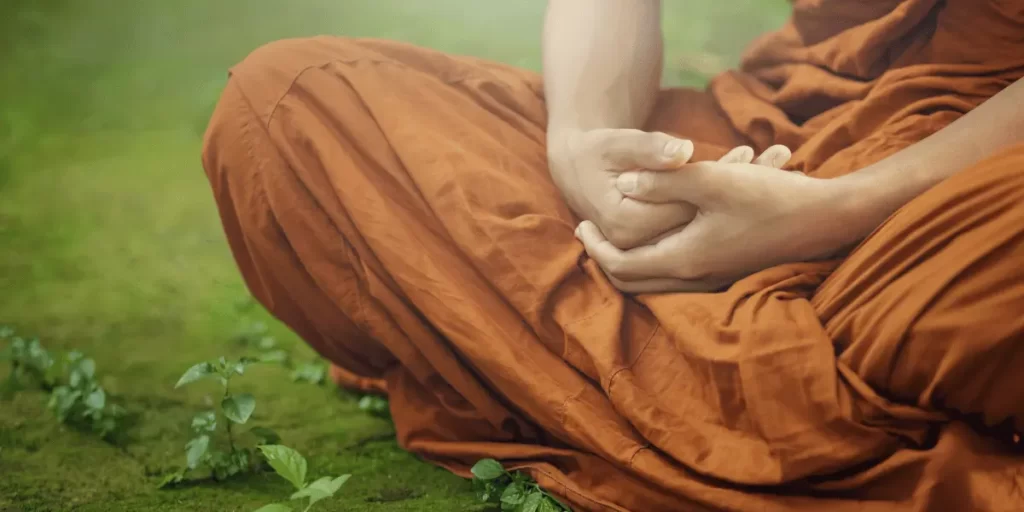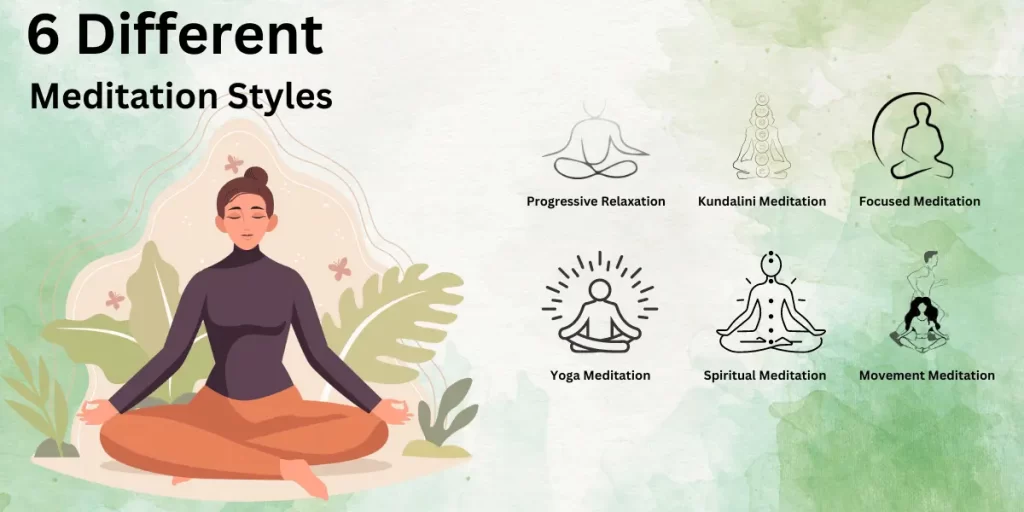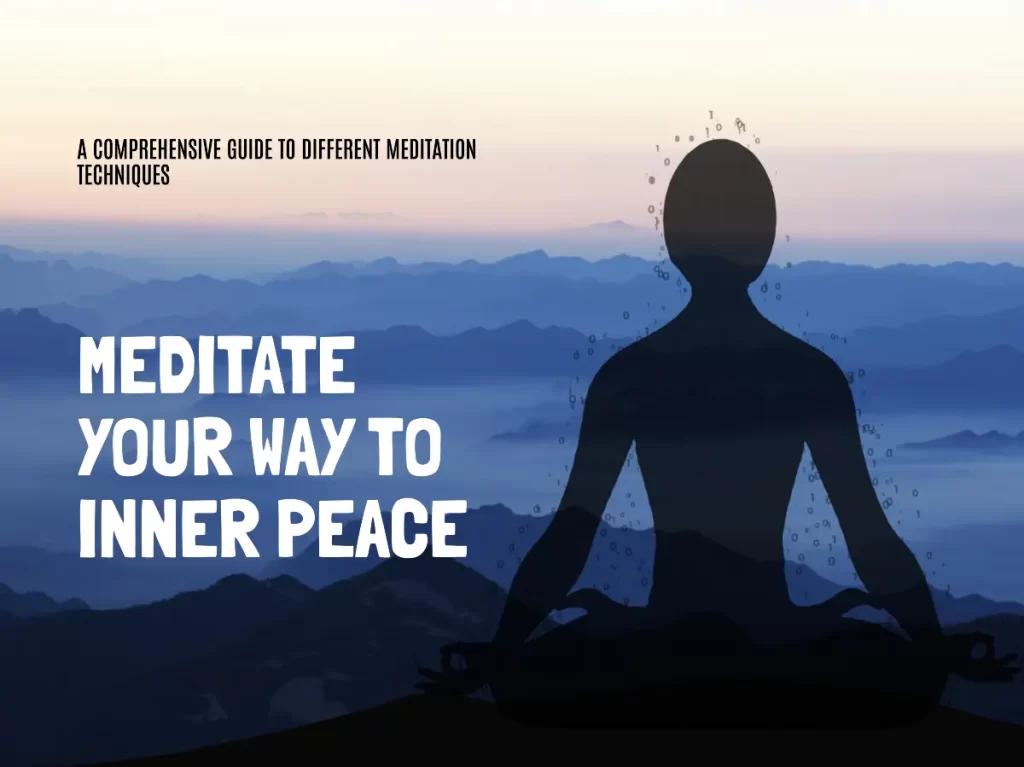Meditation has always made turning points in people’s lives. However, what comes to people’s minds when they hear this is the traditional seated position. But did you know that there are different meditation traditions and styles? Learn the surprising facts in this article.
Exploring the Ancient Art of Meditation

Mediation is an ancient practice that lets you train your mind to be sharpened and focused. Historians believe that this practice originated in Buddhism. No wonder it is sometimes called Buddhist meditation. The Buddha lived in Southeast Asia and that was where he taught. The Buddha founded a path to let people practice seated meditation and breathe their way to lasting peace.
The Many Meditation Faces: A Diverse Tapestry
Indeed, meditation has left a rich tapestry of techniques. Various cultures have tapped into this ancient art. We have the Zen meditation from Japan, the vipassana meditation from India, the Sufi meditation from the Middle East, the transcendental meditation from the Western world, and even African tribal meditation. These different meditation traditions and styles offer a unique opportunity for practitioners to connect with something greater. This has led many to conclude that, indeed, meditation can take many forms.
Six Different Meditation Styles

The art of meditation brings relief and peace to one’s mind and self. It is amazing to see how different people have taken many forms of meditation, depending on the one they enjoy. Learning about the different relaxation techniques puts us in a better position to do something that will benefit us in the long run. Let’s reveal them, shall we?
Progressive Relaxation
This is what people also call body scan meditation. The goal is not to focus or bring awareness. As the name suggests, it promotes relaxation. It is progressive because the meditation involves the tightening and relaxation of one muscle group at a time.
Kundalini Meditation
It makes you tap into the Kundalini energy found below your spine. When you release this energy, it leads to enlightenment. You can perform this kind of meditation using mantras, hands, or chants.
Focused Meditation
In focused attention meditation, you bring your attention to an object of focus. It could be your breath. It could even be listening to a song, counting beads or staring at something. When that is achieved, you employ your five senses to concentrate. In case your mind goes astray, you try to bring it back and focus.
Yoga Meditation
It is considered one of the best movement meditations. It is common as well. It focuses on your breath. A common style of yoga is the Kundalini Yoga.
Spiritual Meditation
This one is obviously concerned with developing spirituality and connecting with a higher power. It is effective in helping you tap into heightened wisdom and guidance. The good thing is you can practice this anywhere – at home or a worship center.
Movement Meditation
This is a kind of meditation that is enclosed with movements like tai chi, qi gong and even walking. It involves connecting you with the present moment.
Diaphragmatic breathing – Vital for meditation and mindfulness
Diaphragmatic breathing helps you achieve proper posture. It does so by stimulating your core muscles. Your hips are also stabilized. This makes you grounded and rooted – physically and mentally.
This breathing technique is also key to relieving stress and anxiety. Aside from the above-mentioned, this kind of breathing serves as a ritual before meditation. It supports motivation and stable attention.
Mindfulness Meditation – A tool that gives you Calmness
Yes, this tool helps in paying focused attention to your breath. You do not judge whatever thought arises. You simply acknowledge as they pass. You could observe your bodily sensations and feelings.
This meditation practice helps to relieve stress and improve sleep. It also eases negative emotions you may feel when they show up. What about attention span? It increases it too. Alleviation of stress is also a major benefit of it.
Popular types of this meditation include body scan, breath awareness, and walking meditation. Other ones are mindful breathing and eating. Even mindful listening is one of the techniques of meditation you can employ.
Statistics and Figures on Mindfulness Meditation
Approximately 200-500 million people practice mindfulness meditation worldwide (Statista, 2022)
Americans are also curious about meditation. About 52% of them are interested in trying mindfulness practice (Meditation in America Study, 2022)
More than 14% of people living in the United States have tried meditation at least once. Interestingly, even children meditate.
A good number (about 76%) of people turn to meditation as a health practice.
Due to the popularity of meditation, apps are making huge profits every year.
Transcend the Present with Transcendental Meditation
This is a practice that is aimed at quieting the mind and fostering peace. It uses a mantra to achieve this.
Transcendental meditation was founded in ancient India. The creator was Maharishi Mahesh Yogi. According to the practice, a person is given a personal mantra. This is used to bring vibrational qualities to quiet the mind.
The impact of this mantra-based meditation ranges from lowering blood pressure to improving sleep and reducing anxiety.
How guided meditation works
You could also call guided meditation visualization. That is to say, you form mental images of anything that helps you relax. Then you invoke your five senses. That of sight, smell, touch, taste, and hearing.
This kind of meditation is often led by someone or something else. It could be meditation teachers, a book, a CD or a recording. You will be led to relax your muscles till you are comfortable. Through mental imagery or visualization, you will experience total healing and stress relief.
Table: Popularity of Transcendental Meditation
| Number of Practitioners Worldwide | Celebrity endorsements and influence | |
| United States | 500,000 | Popular celebrities endorse transcendental meditation. We have the likes of Katy Perry and Deepak Chopra. The group called The Beatles also endorse it. |
| India | 100,000 | |
| China | 50,000 | |
| Japan | 20,000 | |
| Others | 700,000 |
Loving-Kindness Meditation – A Compassion Technique
Loving-kindness meditation is synonymously called metta meditation. Both names well describe a focused experience of compassion, love, empathy, and kindness. This serves as the object of meditation. They train us to be open to positive emotions. The traditional practice involves sending love to yourself first. Then you extend it to others. These “others” could be your friend or a loved one, a neutral person in your life, a difficult person, and even the universe.
Who wouldn’t want to experience love? No one of course. This kind of meditation can help to reduce negative emotions and self-criticism. It enhances well-being and life satisfaction, filling you with joy and contentment. It also improves mental health and clarity.
When you cultivate loving kindness, it is easier to understand and accept others. This leads to good social connections and strong bonds in the family.
Unlock Inner Energy with Chakra Meditation
Chakra meditation is mainly concerned with unlocking our blocked chakras. Chakras are our body’s energy centers. The idea of chakra stems from India and has since been given consideration. Chakras are the natural energy flow in the body that heals us of certain problems. An unbalanced chakra is considered dangerous.
Meditators often visualize a flow of energy through the body. This energy activates the chakras and promotes better health.
There is no one technique to balance chakra. Numerous ways are used. Some of the common ones are the practice of yoga, breathwork, and visualization. Aromatherapy or the use of essential oils also unlocks chakra. The use of sound is effective too to align the chakras.
Insight Meditation – Delve into Deeper Truths
Insight meditation helps you see things as they are. This meditation focuses too on breath awareness. It teaches meditators to label thoughts as they arise. Then, they are prompted to take mental notes of anything that grabs their attention.
The goal is to gain insight into your pool of experience through your mental mind. Gaining a good observance of these thoughts helps to improve mental clarity and self-awareness.
Mantra Meditation: The Power of Sound
The mantra meditation is practiced in traditions such as Buddhism and Hinduism. It uses repetitive sounds to clear the mind. Maybe a phrase, a word or even a sound. It could be said aloud or in silence. The repeated word becomes our anchor.
Do you know some of the popular mantras and their meaning? Let’s find out:
Om – As simple as this may sound, it is powerful. It is considered the pure sound of the universe.
So’Ham – It means “I am that”, revealing the fact that all humans have one maker and life source.
Guru Om – It is said to show thanks and respect to one’s guru.
Movement and Meditation: A Harmonious Union
Movement meditation is often a combination of physical movements and the art of mindfulness. As a practice, it helps you find harmony and balance within yourself. Bodily sensations are experienced, emotions are felt and you are brought into the present moment. Unlike the traditional sitting meditation, this one is flexible – making you explore different techniques that suit you.
The yoga meditation, for instance, combines breath with meditation. It engages you through different postures. Thus, you are able to focus on your breath with each movement.
Another common one is walking meditation. It lets you walk slowly and mindfully, paying attention to the sensations around you. This kind of keeps you stabilized and grounded.
From the region of China, we have Tai Chi. This is a slow but graceful movement that brings inner peace and enlightenment. Practitioners create flowing movements that harmonize them with the universe.
Here’s another funny one – ecstatic dance. You may wonder, how is dance connected to meditation? Dancing is a pleasurable activity. Now, when you include bringing awareness and staying in the present moment, you can meditate. The main thing is letting go of judgments and experiences as you dance to the rhythm.
Movement meditation increases physical fitness and flexibility. It can improve heart health and one’s immune system. Regarding the mental effects of meditation, it can reduce anxiety and depression. Boosting resilience and self-esteem is another benefit when you do it.
The Zen Way: Simplicity and Presence
Zen meditation in Japanese means seated meditation. Like other meditation traditions and styles, it lets you focus on your breath and observe thoughts without judgment. However, breath is emphasized in the belly. It also has stricter postures than others, making it ideal for experienced meditators.
Some principles of Zen are:
- Realize that everything is already perfect
- Show kindness and forgiveness
- You can’t escape suffering, but you can end it.
- Do not overly attach yourself to someone or something as it may ruin you.
- Meditation will lead you into the pathway of awakening.
- Judge not; doubt not
- Our logic can be misleading sometimes
Zen meditation techniques listed below are worth trying:
- Zazen meditation, where you bring awareness to the breath in your belly or the area above the navel while sitting.
- Kihin, also known as Zen walking. It is a mindful walk that lets you meditate.
- Koans, are riddles that are not meant to be answered but to open the mind.
- Zen gardening, is simply planting and maintaining a garden, using it as a relaxation spot for meditation.
Visualization: Unlocking the Mind’s Eye
Visualization is calm and peaceful. Its goal is nothing more than to help you focus on positive feelings by visualizing positive scenes or images. Then, you can use your five senses to bring such thoughts to life.
Visualization meditation is used to manifest goals and desires that you hope to achieve. To add to that, this meditation is also used to heighten your commitment to your goals, building confidence and optimism. With your mind’s eye, you can connect to spirituality, uncovering deep inner truths and hurts that need to heal.
Conclusion: Embracing the Different Meditation Techniques
This blog post has extensively explained the different types of meditation traditions and styles – Progressive, Kundalini, Focused, Movement, Spiritual Meditation, and Yoga Meditation.
If you are experienced and you want to try a variety of meditation, you can go through these and find one that suits you. If you are new to meditation, do not also hesitate to hop into any of these and start your spiritual journey.
Resources for Further Exploration
Here’s a list of recommended books, websites, and apps for meditation.
Books:
- The Relaxation response
- Mindfulness in plain English
- Moving Inward: The journey to meditation
Websites:
- http://www.insightmeditationcenter.org/meditation-timers/
- http://www.mindful.org/
- http://www.self-compassion.org/
- http://www.thecenterformindfuleating.org/
Apps
- Headspace
- Calm
- Ten percent happier
- Insight Timer
- Buddhify
Local centers of meditation may also be found near you. Onlinemeditationevents.com can help you find one.
Types of meditation used in the Headspace app
Headspace uses guided meditation, calming meditation (Samantha), and insight meditation (Vipassana). Aside from these, Headspace has over 500+ meditation programs on things about stress, resilience, and even freedom. You can start a free trial on the app.
You Can Also Read This: 12 Types of Meditation Techniques
Frequently Asked Questions(FAQ’s)
1. Mindfulness Meditation 2. Compassion Meditation 3. Concentration Meditation 4. Zen Meditation 5. Vipassana Meditation 6. Loving-kindness Meditation and 7. Mantra Meditation
There are about 9 different kinds of meditation styles that are popular.
Traditional meditation is known by most people and fit for beginners. It is basically practiced in a seated position.
Meditation came from the Vedic times of India. True, different culture has different meditation methods. But it is generally believed that it leads to spiritual enlightenment.
Samma-samadhi is the highest. When you attain this, you gain insight and understand things as they really are.
1. Carve out time for yourself. 2. Get comfy in your own space 3. Begin with mindfulness 4. Start meditating 5. Bring your mind to focus 6. Let go of disturbing thoughts 7. End the session
Of course, it certainly does. It gives a promising avenue for people to relieve their stress.
It means using many meditation techniques to unblock, balance, and align your chakras.
There are different traditions and styles, each holding the prospect of bringing you calmness and peace. You can start with any of your choices in small sessions and see how it works for you. Feel free to change if the need arises.
Anyone – men, women, children who would love to experience peace.

